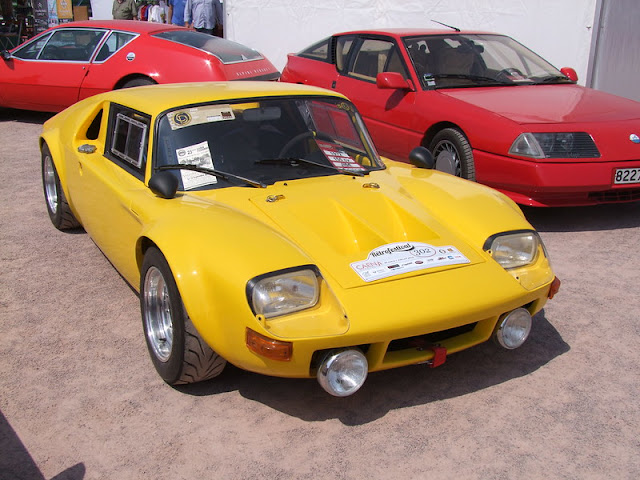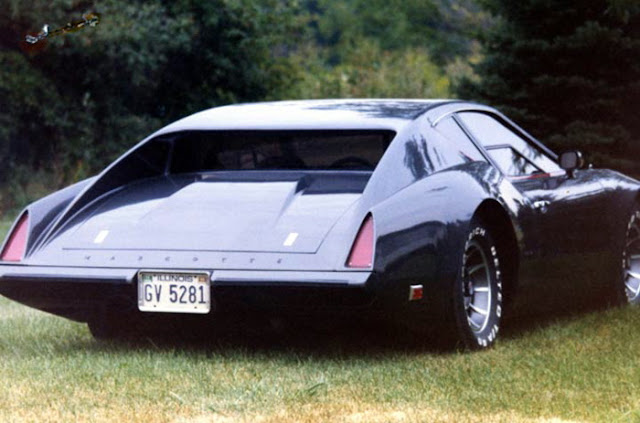A French Berlinette
The Jidé was created by French engineer and entrepreneur, Jacques Durand, in 1969. It's marque and model name were derived from his initials "JD". The design was penned with competition in mind and drew from its creator's experience, which dated to the early 1940's. Production began in Chatillon sur Thouet in 1969 but the car was not officially presented at the Racing Car Show until 1970.
The Jidé coupe was tiny, with a length of 3.6 meters and a height of just one meter! The bodywork stout, taut, with inspiration from the Ford GT40. Like other low volume makes, it utilized many parts from mass produced cars such as headlights from a Matra 530 under Perspex, the windshield of the Renault Florida, and the taillights and door handles of Renault 8.
In 1970 the kit (the body, doors, hoods, and bespoke chassis, with Renault interior components) was sold for 6300 Francs. For 10000 F, the car could be delivered partially assembled, sans engine and front axle. For the 1300 Gordini version, with the complete package and drivetrain, it was necessary to spend 23800 F.
The Jidé was one of the only "kit-cars" to have passed all homologation tests at UTAC (frontal impact, handling, braking, etc.) in 1972, requiring the destruction of 2 complete cars. All examples built from 1973 received a registration card in the name of Jidé. As such, they received a national chassis number in the name of Jidé (6-digit number starting from the number 100).
The powertrain was derived from the Renault R8, with an 1100cc motor or a 1300cc unit from the R8 Gordini. The 1300cc version made 88bhp, at 6700rpm, making it comparable to the Alpine A110 of the time. The engine was mounted mid-rear, with the transmission reversed, like the Formula Renault.
The chassis consisted of a central backbone, with outriggers at the sides, in box section tubular steel. It integrated a Gordini crossbeam and two spars at the rear, to which the motor was mounted. The chassis was bonded to the polyester body with resin. The front axle was also from the R8 Gordini with a Dangel system of cams used to adjust the camber and the rear axle was actually the front axle of an R12 Gordini mounted upside down and locked. The brakes were dual-circuit and used the discs of Renault 16 TS at the front and R12 at the rear.
As development continued, Durand decided to increase the power on tap, to make it more competitive. So, for 1972, the Jidé 1600 was fitted with the engine from the R16 TS developing 83 hp at 5750 rpm. The Jidé 1600 S received the 1565cc unit of the R12 Gordini, which delivered 113hp at 6250rpm and 140 Nm of torque at 4500rpm, as well as its 5-speed box for 26600 F. The hottest version was the one developed for racing, the 1600 S Competition. It used the 1600 Gordini equipped with the 807 G kit with a Lucas carburetor or fuel injection, developed by Renault-Gordini engineers. The modifications included a new jacket and piston assembly with a displacement of 1596cc, segmentation, lightweight connecting rods, camshaft, spark plugs and intake.
Durand designed the Jide with racing in mind, but lacking the means to create a factory team, he lent cars to privateers who absorbed the costs of entry. The Jidé began to race officially in 1969 at the Tour de France automobile with Patrick Champin and Pierre Madelaine. In 1972, 1600 S Competitions were entrusted to the hands of Jean Ragnotti and Henri Rimaudière who were victorious at the Poitou Rally. Michel Robini raced one in the national rally (group 5), regional and national hill climbs and slalom competitions until 1974.
The Jidé continued its sporting career with the trainer and driver Georges Queron on his Jidé 1860 or 1600, which raced until 1980, when the Jidé moved to Group N. In 1981, he raced with an i2000, an enlarged and elongated Jidé with a new chassis and a 2.0 liter of the R20, tuned to produce 200 hp. Christian Alexandre and Charly Carcreff would start racing the Jidé in 1983. Christian Alexandre continued to drive his Jidé until 2005.
In 1973, the Jidé received an integrated spoiler at the front, slightly enlarged wheel-arches, a spoiler, and wider rims. The other aesthetic modifications that can be seen in surviving models were made by the owners themselves or by their various buyers after 1974. Like his competitor Jean Rédélé and his Alpine A108, Jacques Durand sold a production license of his Jidé to the company Plastique Technique, based in Mohammedia, Morocco which specialized in boat hulls and built 9 examples. Unfortunately, at the end of 1973, like many other small French manufacturers, the embargo on oil, the suspension of races on French soil, and resulting financial difficulties prompted Jacques Durand to sell the whole Jidé concern to Michel Baxas.
In 1980, Jacques Herment created the Jidé club and purchased the molds and tooling from Michel Baxas, who no longer had the money to continue. Jacques Herment finished the few remaining copies and sold 6 kits and spare parts. In 1990, Jean-François Humeau revived the Jidé brand, passed the requisite UTAC tests, modernized some elements, and built 25 copies until 1993, with a new Citroën GS windshield. The coupe was then sold for 150,000 Francs. Then it was Lucien Cosnefroy's turn to resume the construction of 5 copies and continue to manufacture elements for the Jidé. The cars continue to compete in vintage races across Europe and a small enthusiast community is supportive of these efforts.
Production of the Jidé
Jidé (Mounted) 1969-1974: 120 copies
Jidé (In kit form) 1969-1974: 50 copies
Jidé (Humeau) 1990-1993: 25 copies
Jidé (Cosnefroy) 1994: 5 copies
Sources:
Information presented here leans heavily on this article.
Images were found publicly shared on Flickr.
 |
| A yellow Jidé in mild tune |
 |
| A Jidé under acceleration |
 |
| A heavily modified Jidé, set up for hill climbs and road racing |
 |
| A Jidé with a custom facia and air dam. |
 |
| A Jidé with aerodynamic mods and wide track. |
 |
| A Jidé in dark blue |
 |
| A Jidé, rear quarter view, queuing up at the track |










Comments
Post a Comment